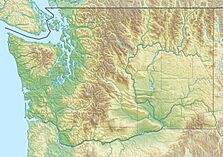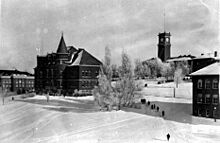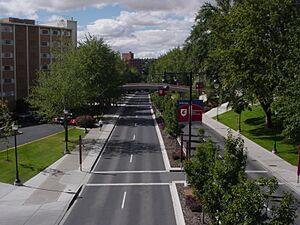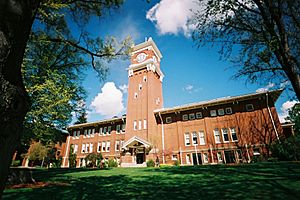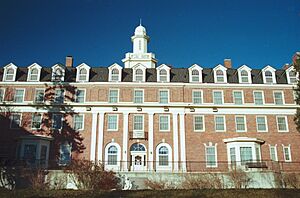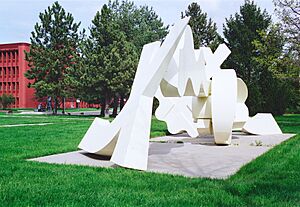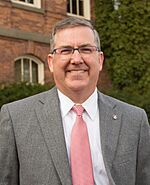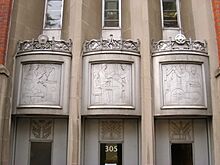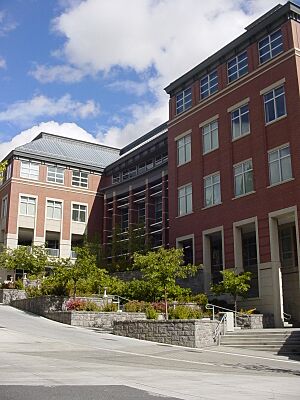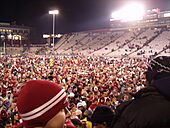Washington State University facts for kids
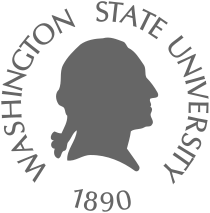 |
|
|
Former names
|
Agricultural College, Experiment Station and School of Science of the State of Washington (1890–1905) State College of Washington (1905–1959) |
|---|---|
| Type | Public land-grant research university |
| Established | March 28, 1890 |
| Accreditation | NWCCU |
|
Academic affiliation
|
|
| Endowment | $1.29 billion (2021) |
| President | Kirk Schulz |
| Provost | Elizabeth Chilton |
|
Academic staff
|
2,261 |
| Students | 31,471 – (Total) 20,976 – (Pullman) 1,685 – (Spokane) 1,813 – (Tri-Cities) 283 – (Everett) 3,585 – (Vancouver) 3,265 – (Global Campus/WSU Online) |
| Undergraduates | 26,062 – (Total) 18,346 – (Pullman) 534 – (Spokane) 1,603 – (Tri-Cities) 3,170 – (Vancouver) 283 – (Everett) |
| Postgraduates | 4,262 – (Total) |
| 1283 – (Total) | |
| Location |
,
,
United States
46°44′N 117°10′W / 46.73°N 117.16°W |
| Campus | Distant town, 1,742 acres (7.05 km2) |
| Other campuses | |
| Newspaper | The Daily Evergreen |
| Colors | Crimson and gray |
| Nickname | Cougars |
|
Sporting affiliations
|
|
| Mascot | Butch T. Cougar |
 |
|
Washington State University (WSU), also known as Wazzu, is a large public university in Pullman, Washington. It was started in 1890. WSU is one of the oldest "land-grant" universities in the western United States. A land-grant university is a special type of college that focuses on teaching practical subjects like agriculture and engineering.
WSU is the second-largest university in Washington state. It has about 24,000 undergraduate students and over 28,000 students in total. The university is known for its high level of research.
The main WSU campus in Pullman is on a hill. It has open spaces and buildings made of red brick. The university is in the Palouse region, which has rolling hills. WSU also has other campuses in Washington: Spokane, Tri-Cities, and Vancouver. These were all started in 1989. In 2012, WSU began an online program called Global Campus. A sixth campus opened in Everett in 2015.
WSU's sports teams are called the Cougars. Their school colors are crimson and gray. The Cougars compete in NCAA Division I in the Pac-12 Conference.
Contents
History of Washington State University
Early Years and Founding
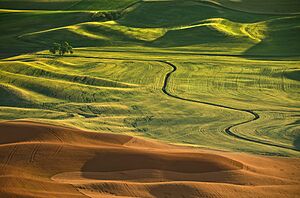
In 1862, President Abraham Lincoln signed a law called the Morrill Act. This law helped create "land-grant colleges." These colleges were meant to teach farming and mechanical skills. They also aimed to give a good education to working-class people. Later, the Hatch Act of 1887 added money for farming research at these colleges.
Washington became a state in 1889. Soon after, on March 28, 1890, a bill was passed to create the "Agricultural College, Experiment Station and School of Science of the State of Washington." Governor Elisha P. Ferry signed it into law. The school's goal was to improve farming and teach useful skills. It also included general arts and sciences.
A committee chose Pullman as the location for the new college. Pullman was picked partly because the city gave land for the school. It also had good railroad connections. The college opened on January 13, 1892, with 59 students. It offered studies in agriculture, engineering, and home economics. The first group of students graduated in 1897.
The Bryan Era and Name Change
Enoch Albert Bryan became president in 1893 and served for 22 years. Many people see him as the true founder of the university. Before Bryan, the school had many problems. Under his leadership, the college became much stronger.
Bryan made sure the school taught both practical skills and liberal arts. Students had to take classes like chemistry, math, history, and English. He also added music and art programs. Bryan helped the college gain respect. The famous clock tower on campus is named after him.
In 1905, the school officially changed its name to the "State College of Washington." People often called it Washington State College (WSC).
Growth and Challenges
Ernest O. Holland became president in 1915. WSC faced challenges, especially with the University of Washington (UW). Some lawmakers wanted WSC to be only a "trade school." But WSC fought to keep its wider range of studies.
The Great Depression in the 1930s caused money problems for WSC. Student numbers and salaries went down. During World War II, the college helped the war effort. It trained soldiers and taught Japanese. This was also when the famous Cougar Gold cheese was first made. It was developed by a dairy scientist named Dr. N.S. Golding.
After the war, many former soldiers came to WSC using the G.I. Bill. The campus became very crowded.
Becoming a University
On September 1, 1959, the state officially changed the school's name to Washington State University. This showed that the university had grown and matured. WSU joined a major athletic conference in 1962. The university also started new doctoral programs and built a small nuclear reactor for research.
By the 1970s, WSU had grown to 14,000 students. President Glenn Terrell worked to get more money for education.
Expanding Across the State
WSU grew a lot starting in 1985 under President Samuel H. Smith. In 1989, WSU opened new campuses in Spokane, the Tri-Cities, and Vancouver. Smith was very good at raising money for the university. He raised about $760 million, partly with help from Microsoft co-founder Paul Allen.
In the 1990s, WSU worked to improve its image. It focused on improving the quality of education. President V. Lane Rawlins raised admission standards. He also worked to improve classes and research facilities.
Elson Floyd became president in 2006. He focused on increasing student diversity and making the university more well-known. Under his leadership, student numbers went up by 17 percent. Research grants tripled to $600 million a year. He also helped create a public medical school in Spokane. This medical school, named after him, helps with the doctor shortage in rural Washington. WSU aims to be among the top 25 public research universities by 2030.
Campus Life at WSU
The main WSU campus in Pullman is about 620 acres (2.5 km2) big. It is in the Palouse region. The campus is about seven miles (11 km) west of the Idaho border. The nearby city of Moscow is home to the University of Idaho, another land-grant school.
The Palouse region is known for its unique rolling hills. These hills were formed by wind-blown soil. This area is great for growing crops like wheat, peas, and lentils. The campus sits on College Hill, overlooking downtown Pullman.
Campus Buildings and Design
WSU has many different kinds of buildings. Many older buildings in the center of campus are made of red brick. They were built between the two World Wars. Later, some modern buildings were added, like the Regents Hill dorms.
Newer buildings include an addition to the Holland Library, which has curving windows. There is also a large Student Recreation Center. The Samuel H. Smith Center for Undergraduate Education, or "CUE," is another important building.
The busiest part of campus is the Glenn Terrell Friendship Mall. This walkway used to be a road. It is named after former WSU president Glenn Terrell. The main libraries, student union, and academic buildings are around this mall.
Martin Stadium, where the football team plays, is also on campus. It is near the center of the campus. Football has been played here since 1895. The stadium was rebuilt in 1972. It has been updated to add more seats and better facilities for fans and players.
Other old and important buildings include Thompson Hall (1895) and Stevens Hall (1896). Thompson Hall used to be the main administration building. Bryan Hall (1909) is very noticeable with its tall clock tower. Stevens Hall is believed to be the oldest women's dormitory west of the Mississippi River. Both Stevens Hall and Thompson Hall are on the National Register of Historic Places.
The Lewis Alumni Centre used to be a beef cattle barn. It was changed into event spaces and offices for alumni. Webster Hall, built in 1974, is the tallest building on campus. It has great views of the area.
Living on Campus
WSU is a residential campus, meaning many students live there. Most freshmen live in residence halls. Some students live in fraternity or sorority houses. Others live in apartments near campus.
There are many different residence halls. Some are for both boys and girls, while others are for one gender. There are also special living options, like housing for older students or for international students. Each residence hall has its own student government. This group plans events and manages the hall's budget.
The residence halls include:
- The Hill Halls: Community/Duncan-Dunn, Elmina White Honors Hall, McCroskey, Wilmer-Davis and Stevens
- The Northside Halls: Regents Hill, Scott/Coman, Streit-Perham, Northside, and Global Scholars
- Southside Halls: Stimson, Waller, Gannon-Goldsworthy, Rogers, Orton, McEachern, and Olympia
- The Stephenson Residential Complex: Stephenson East, Stephenson North and Stephenson South
Greek Life
WSU has many fraternities and sororities. These are social organizations that students can join. About 25 to 30 percent of undergraduate students are part of the Greek community. Greek students often have higher grades. They join by going through a "recruitment" process. WSU has a strict rule against hazing.
Greek Row is the area where many fraternity and sorority houses are located. It is part of College Hill, a diverse neighborhood near campus. College Hill also has restaurants and shops.
Fun and Outdoors
The university has a huge Student Recreation Center (SRC). It opened in 2001 and was one of the largest in the U.S. It has an indoor track, basketball courts, a swimming pool, and a large Jacuzzi. Students can also use weight rooms and exercise classes.
The campus has other sports facilities, including a climbing wall. The Outdoor Recreation Center lets students rent equipment for outdoor activities. The Bill Chipman Palouse Trail is a seven-mile (11 km) bike trail that connects Pullman to Moscow, Idaho. Another bike trail goes around the Pullman campus.
In 2008, WSU opened a new championship golf course called Palouse Ridge. It helps the school's golf teams and provides a place for students to study turf grass.
Students can also enjoy nature nearby. Kamiak Butte and Steptoe Butte are good for hiking. The Snake River offers opportunities for cliff jumping and boating. Farther away, students can go white-water rafting, skiing, and hiking in the Rocky Mountains.
Campus Green Efforts
WSU works to be environmentally friendly. It has buildings that meet LEED-silver standards for energy efficiency. The university uses energy-saving lights and systems. It also tries to reduce wasted power.
WSU gets some of its energy from a plant on campus that uses natural gas. The university is working to lower its carbon emissions. WSU is also involved in clean energy research.
Students can get funding from the Cougar Green Fund for ideas to improve campus sustainability. WSU also has a free bike-sharing program called Greenbike.
Museums and Collections
The Museum of Art/WSU has several art collections. These include works from past university presidents and famous artists. There is also a lot of outdoor art on the Pullman campus. Many of these art pieces are supported by a state program that sets aside money for public art.
The Museum of Art also creates traveling exhibitions. These shows have been seen by many people across the country.
Other museums and collections at WSU include:
- The Charles R. Conner Museum of Natural History: This museum has over 700 stuffed birds and mammals. It also has more than 65,000 research specimens.
- The Museum of Anthropology: This museum has collections of ancient tools and items from different cultures. It also has items from Native American tribes in the Inland Northwest.
There are also collections of fossils, minerals, historic costumes, and insects.
How WSU is Organized
The university offers many different degrees. Students can earn bachelor's, master's, and doctoral degrees in 200 areas of study. These are offered through 65 departments and programs.
Colleges at WSU
These departments are organized into 10 main academic colleges:
- College of Agricultural, Human, and Natural Resource Sciences
- College of Arts and Sciences
- Carson College of Business
- Edward R. Murrow College of Communication
- College of Education
- Voiland College of Engineering and Architecture
- Elson S. Floyd College of Medicine
- College of Nursing
- College of Pharmacy
- College of Veterinary Medicine
WSU also has an honors college for gifted students. It has a graduate school and an online global campus. There is also a program to help non-native English speakers learn English.
University Leadership
A group called the board of regents leads the university. They are appointed by the governor of Washington. They guide the university and its president. There are ten regents, including one student regent.
Kirk Schulz is the current president and chief executive officer of WSU. He is in charge of the entire university system. The provost, Daniel Bernardo, handles academics, research, and faculty matters.
WSU has had 11 presidents in its history. Each president has helped shape the university.
WSU Foundation
The WSU Foundation is a separate group that raises money for the university. It has its own board and CEO.
Faculty Senate
The faculty senate is a group that represents the university's more than 2,261 faculty members. They approve all major academic decisions. The senate has members from each college and campus.
Academics at WSU
Becoming a Student
For the 2022-2023 school year, WSU's undergraduate admissions were "less selective." This means many students who apply get accepted. About 86% of applicants were admitted.
Fall freshman statistics*
| 2016 | 2015 | 2014 | 2013 | 2012 | 2011 | 2010 | 2009 | 2008 | |
|---|---|---|---|---|---|---|---|---|---|
| Applicants | 23,223 | 19,766 | 18,563 | 14,887 | 14,825 | 14,071 | 12,427 | 12,478 | 11,983 |
| Admits | 16,731 | 15,742 | 15,017 | 12,219 | 11,268 | 11,601 | 8,634 | 9,489 | 8,677 |
| % admitted | 72.0 | 79.6 | 80.9 | 82.1 | 76.0 | 82.4 | 69.4 | 76.0 | 72.4 |
| Enrolled | 4,527 | 4,727 | 4,458 | 4,163 | 4,389 | 4,473 | 3,288 | 3,668 | 3,710 |
| Avg GPA | 3.40 | 3.32 | 3.29 | 3.29 | 3.30 | 3.35 | 3.44 | 3.42 | 3.48 |
- WSU does not require students to submit SAT/ACT test scores as part of the application
process and does not use them in admission decisions.
What You Can Study
WSU has 12 colleges and a graduate school. You can study many subjects, including business, communication, education, architecture, pharmacy, nursing, agriculture, engineering, and veterinary medicine.
WSU offers over 200 fields of study. This includes 98 main majors and 86 minors. There are also over 140 graduate degrees. WSU gives out almost 5,900 degrees each year. Over 1,400 teachers work at WSU.
University Rankings
|
|
|
||||||||||||||||||||||||||||||||||||||||||||||||||||||||||||||||||||||||||||||||||||||||||||||||||||
U.S. News & World Report ranked WSU tied for 212th among all national universities in 2022-2023. It was also ranked 107th among public schools. WSU's College of Veterinary Medicine was ranked 14th in the U.S. in 2019.
The Academic Ranking of World Universities placed WSU globally in the 301–400 range in 2020. QS World University Rankings ranked WSU 400th in the world for 2020.
WSU Libraries
The WSU Libraries manage three main libraries on the Pullman campus. They also oversee libraries at the WSU Health Sciences, Tri-Cities, and Vancouver campuses.
WSU Libraries work with other university libraries in Washington and Oregon. This allows students to borrow books from many different schools. The libraries have over 2.2 million print books. Students also downloaded over 2 million online items in 2012.
Research at WSU
In 2018, WSU spent $360 million on research and development. This ranked it 71st in the nation.
Research at WSU started with agriculture, which is common for land-grant universities. Early faculty members taught subjects like farming, plants, and animal science. WSU's wheat research program helps Washington's wheat industry.
The university's food and agriculture research supports the state's $29 billion food industry. WSU scientists helped create the state's $3 billion wine grape business. They are also working on the Apple Genome Project to map the apple's genes.
Food science is another important research area. In the 1940s, WSU developed the famous Cougar Gold cheese. This white cheddar is still made at the WSU Creamery. WSU researchers also developed a way to use microwave energy to make pre-packaged foods safer.
WSU's plant science faculty are ranked highly in the nation. Their animal science and food science faculty are also top-ranked. WSU's farming research has helped create sustainable farming methods.
Veterinary medicine and animal health are also key research areas. A $25 million grant helped build a research facility for the School for Global Animal Health. Scientists there study animal diseases and how to stop them from spreading.
In clean technologies, WSU researchers work to make the power grid better. They also improve air quality forecasts. They are developing an algae-based biofuel that uses greenhouse gases. Scientists at WSU were the first to create "nanosprings."
WSU also has one of the few nuclear research reactors in the country. It is used for research and to teach about the nuclear industry.
Other research includes studies on sleep, shock compression science, and how living things change over time. WSU research has led to important discoveries. These include finding ancient human remains, developing high-yielding wheat, and creating new fruit varieties like the Rainier cherry and Cosmic Crisp apple.
Helping the Community
The WSU Extension has offices in all 39 counties in Washington. They help with farming, natural resource management, and life skills. They also run the state's 4-H program for kids.
WSU also helps small businesses. They offer advice on starting and growing small companies.
The WSU Creamery is a teaching program that makes dairy products. Their Cougar Gold cheese is very famous. It is a sharp white cheddar aged for at least one year. They also make other types of cheese.
Washington State University Press publishes books about the American West. These books cover history, environment, and culture of the Northwest.
Students at WSU can volunteer in the community. They do about 30,000 hours of service each year.
Student Life at WSU
| Race and ethnicity | Total | ||
|---|---|---|---|
| White | 60% |
|
|
| Hispanic | 17% |
|
|
| Other | 9% |
|
|
| Asian | 6% |
|
|
| Foreign national | 4% |
|
|
| Black | 3% |
|
|
| Economic diversity | |||
| Low-income | 27% |
|
|
| Affluent | 73% |
|
|
Student life at WSU is shaped by many student groups. These groups plan fun and educational events for students and the community. Some groups focus on different cultures, like the Asian Pacific American Student Coalition. Others focus on the environment or international students. There are over 300 registered student organizations (RSOs) for many interests.
The Associated Students of Washington State University (ASWSU) is the main student government for undergraduates. It has a president, vice president, and a senate. The senate helps decide how money is given to student groups.
The Graduate and Professional Students Association (GPSA) is for graduate students. It also has a senate with representatives from different programs.
Students have helped make big changes on campus. They voted to improve Pullman Transit's bus service. They also voted to remodel the Compton Union Building, which is the student union.
Student Media
Washington State Magazine is the university's magazine for alumni and research. It comes out four times a year. WSU News is the official news website and daily email for staff and students.
The Daily Evergreen is WSU's student newspaper. It has been published since 1895.
WSU also has its own radio and TV stations. Northwest Public Radio and Television are owned by the university. KWSU 1250 in Pullman started broadcasting in 1922. Famous broadcaster Edward R. Murrow began his radio career at WSU.
Cable 8 Productions is a student-run TV channel. KZUU 90.7 FM is a student-run college radio station. KUGR Sports Rock is an online student radio station. Many students who work at these media outlets are studying broadcasting.
School Song
"The Fight Song" is WSU's official fight song. It was written in 1919 by students Phyllis Sayles and Zella Melcher. The lyrics are on the WSU website.
WSU Athletics
Washington State University is part of the Pac-12 Conference. The school's mascot is "Butch T. Cougar" and the colors are crimson and gray. WSU has many varsity sports teams for men and women. These include baseball, basketball, football, golf, track and field, soccer, swimming, and volleyball.
WSU has won national championships in men's basketball (1917), boxing (1937), and indoor track and field (1977).
The university also supports 26 club sports. These are student-run teams that compete against other colleges. Examples include bowling, cricket, ice hockey, lacrosse, rugby, and skiing.
WSU's biggest sports rival is the University of Washington Huskies. They also have strong rivalries with the University of Oregon Ducks and Oregon State University Beavers. WSU's closest rival is the University of Idaho Vandals, which is only seven miles (11 km) away. Their football game is called the "Battle of the Palouse."
Famous People from WSU
As of 2015, WSU has over 196,000 living alumni. Many famous people have attended or graduated from WSU.
Some notable alumni include:
- Irwin Rose: Won the Nobel Prize in Chemistry in 2004.
- Edward R. Murrow: A very famous broadcaster.
- Ana Cabrera: A well-known journalist.
- Paul Allen: Co-founder of Microsoft (attended, but did not graduate).
- John M. Fabian: An astronaut.
- Gary Larson: The cartoonist who created "The Far Side."
- Dolph Lundgren: An action movie star (attended one year).
- George Reed: A Canadian Football League champion.
- Bernard Lagat: An Olympic runner.
- James P. Fleming and Ronald Shurer: Both received the Medal of Honor for their bravery.
- Timothy Leary: A counterculture icon.
- Krist Novoselic: A musician, known as the bassist for Nirvana.
- Edmund Schweitzer: Founder of Schweitzer Engineering Laboratories (SEL).
See also
 In Spanish: Universidad Estatal de Washington para niños
In Spanish: Universidad Estatal de Washington para niños



